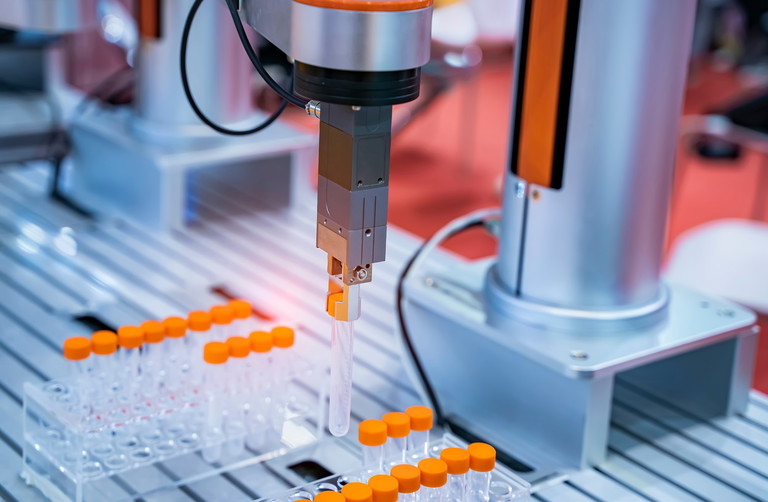Lab Design: Automation
Smarter labs, better discovery: how automation is evolving pharma R&D
How is the industry translating the potential of automated technologies into practical, flexible and scalable workflows that address the real-world challenges of modern laboratories, ensuring that innovation delivers measurable scientific and operational gains?
Joby Jenkins at SPT Labtech
From precision liquid handling to intelligent storage and adaptive scheduling, automation continues to transform pharma R&D. But real impact comes not just from new technologies, but from how they are implemented with flexibility, foresight and a clear understanding of evolving scientific needs.
The automation imperative in modern drug discovery
Pharma is under pressure to move faster, uncover deeper insights and deliver results with greater accuracy than ever before. As pipelines expand and experimental complexity increases, automation offers a strategic solution. Applied sensibly, automation consistently delivers higher-quality data. It’s not just about speeding things up, it’s about improving scientific decision-making.
Automation removes the variability of manual processes, reduces reagent waste, increases reproducibility and frees scientists to focus on experimental design rather than execution. While simple point solutions can deliver quick wins, the full value of automation lies in how different systems come together to form an intelligent, adaptable workflow.
Scaling automation: a spectrum, not a switch
The journey to full lab automation isn’t linear. Some organisations start with electronic pipettes or automated decappers. Others aim straight for integrated robotic systems that orchestrate end-to-end workflows, including liquid handling, compound management and data processing.
Successful labs avoid jumping into automation too early. Moving directly from a functional manual assay to a bespoke, fully automated system carries risk: such systems may perform one task exceptionally but often prove expensive, rigid and difficult to adapt when workflows change.
A modular, stepwise approach delivers greater resilience. Future assay requirements and desired data outputs should guide system design. What kinds of assays will the lab need to run in a year from now? What data outputs are needed? Automation must be able to scale and adapt as scientific needs evolve.
Automation and scientific confidence
One of the less discussed, but most valuable impacts of automation is how it boosts scientific confidence. Consistent, high-quality data allows results to be interpreted more decisively, reduces troubleshooting and accelerates progression to the next stage. Scientists are constantly making decisions based on data. If the data can’t be trusted because of variability, missed metadata or inconsistent handling, it slows everything down.
In collaborative environments, where data sets are shared across teams or organisations, standardised workflows and reliable metadata are essential. Automation ensures experiments can be repeated, scaled and integrated into artificial intelligence (AI) systems with reproducible inputs. In many cases, scientists in manual workflows spend as much time verifying samples as running experiments. Automated processes eliminate this burden, enabling scientists to focus on analysis and innovation. With this foundation of trust in data, labs can begin to explore more ambitious applications of automation across a range of scientific domains.
Where automation delivers strategic impact
To understand where automation adds the most value, it’s useful to look at the areas where it directly accelerates discovery:
Assay development: designing better experiments
One area seeing rapid innovation is automated assay development. Here, automation works hand in hand with statistical tools like Design of Experiments to replace manual trial and error with structured, data-rich experimentation. Multiple parameters can be tested simultaneously to understand interactions and optimise outcomes more quickly. Pharmaceutical companies including GSK and AstraZeneca have demonstrated significant reductions in assay development timelines by using such approaches, particularly when coupled with advanced liquid handling systems. These methods deliver more reliable, higher-quality results earlier in the discovery process, alleviating a major bottleneck in drug development.

Liquid handling: foundation of precision
High-throughput liquid handling remains a backbone of automated labs. Modern systems go far beyond replicating hand pipetting. They offer non-contact dispensing, positive displacement, miniaturisation and AI-enabled interfaces that lower the barrier for use. Ease of operation is a defining feature of the latest generation of systems. Scientists can specify experimental requirements directly, without requiring an automation engineer for programming. Integration with barcode scanners, laboratory information management systems and scheduling software enables full traceability and precise low-volume dispensing across thousands of samples.
Structural biology: deeper insights, faster
Automation’s benefits aren’t limited to speed – they also unlock insights that would otherwise be inaccessible. Crystallography is a striking example. Twenty years ago, crystallising proteins and screening ligands was slow, labour-intensive and hit-or-miss. Now, with automated low-volume liquid handling, it can be done with tiny amounts of protein and high reproducibility. It’s transformed structure-based drug design. The combination of automation with technologies like cryo-electron microscopy and predictive models such as AlphaFold supports earlier and more informed decision-making in the drug discovery pipeline. These advances provide insights that were previously impractical or impossible to achieve at scale.
Data management: the make-or-break factor
As automation becomes more integrated, the importance of data management grows. Labs must be able to aggregate, track and analyse experimental data from multiple instruments, and automation needs to support that.
It is often underestimated how much manual aggregation scientists do. In a manual workflow, the scientist connects the dots; annotating results, checking barcodes and validating transfers. Once it is automated, that responsibility shifts to the system. This shift demands robust infrastructure; not just instrument control, but data tracking from start to finish. When this is done well, it enables real-time decision-making and significantly reduces experimental cycle time.
Preparing for closed-loop experimentation
A key concept gaining traction is ‘closed-loop experimentation’, where data from an experiment feeds directly into the next experimental design, potentially without human input. While full implementation is still on the horizon, some areas, like chemical synthesis, are already exploring the possibilities.
Structured, high-quality data is essential. Automation helps by removing the human inconsistency, while flexible systems allow workflows to adapt on the fly. Requirements may include new reagents, altered assay formats or different readouts; rigid systems are unable to respond effectively to such changes.
AI models require data sets that are both consistent and well annotated. Automation captures not only successful outcomes but also failed experiments and the associated metadata, ensuring data sets are robust enough to support predictive modelling.
Even as AI matures, full autonomy isn’t always the goal. In the near term, semi-closed-loop approaches where humans validate AI-generated experimental suggestions are likely to be the dominant model. This hybrid strategy allows automation and AI to handle complexity at scale while maintaining human oversight.
Storage, but not as you know it
In a modern lab, sample storage and handling are no longer passive. Distributed, intelligent storage systems now support real-time sample tracking, dynamic allocation and integration with experimental workflows.
Instances of missing samples, misread barcodes or swapped tubes are not uncommon in high-pressure laboratory environments. Such uncertainties are unacceptable when working with high-value materials and tight timelines.
Automation provides the security and traceability necessary to maintain confidence in results.
It’s also important not to underestimate the importance of storage-related processes. The torque on tightening a screw cap might sound trivial, but if it’s too tight or too loose, systems may jam, or worse, the cap may come off. Even label placement affects whether a barcode is scannable later in the process – obviously automated labelling provides a level of consistency humans cannot. These small inconsistencies can break entire workflows.
In high-throughput environments, standardisation becomes essential. Automated systems ensure reproducibility at every step, from storage to assay set-up, eliminating human variability that can compromise results.
The human element: partnering for success
Technology alone doesn’t deliver automation success. True impact comes from partnerships between scientists, automation engineers and system providers. An automation provider must understand the scientific objectives, operational constraints and long-term goals of the laboratory. Collaboration with multiple vendors, open active pharmaceutical ingredients and shared data formats ensures that systems integrate smoothly into complex R&D environments.
What comes next?
As labs adopt more advanced automation, what should pharma companies do today to prepare? The future is flexible, scalable and integrated. Investment in systems capable of growth, a focus on data quality and consideration of the bigger workflow picture will position organisations for success. Ultimately, automation is about enabling better science. When thoughtfully deployed, it reduces manual burden, accelerates iteration and makes data more actionable – all of which are critical as AI and machine learning become more central to discovery.
Conclusion: designing labs that learn
Pharmaceutical innovation is moving into a new era, one driven by data, powered by automation and shaped by AI. But real transformation doesn’t come from buying the flashiest tools. It comes from designing workflows that are robust, flexible and aligned with scientific objectives. Automation enables that future, not by removing scientists from the equation, but by empowering them to do more – explore new ideas, test hypotheses rapidly and act on insights with confidence.
Reproducibility isn’t an aspiration anymore; it’s a feature of the system. The lab of the future won’t just be automated. It’ll be intelligent.

Joby Jenkins is chief technology officer at SPT Labtech. Joby has been part of SPT Labtech since its foundation within TTP Group over 20 years ago and throughout its growth journey, holding numerous positions in both commercial and technical leadership. In his role as chief technology officer, Joby continues to steer the technical direction of the organisation, driving towards the mission of making a real difference to human health.